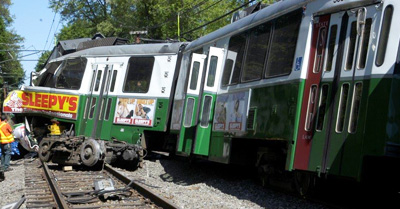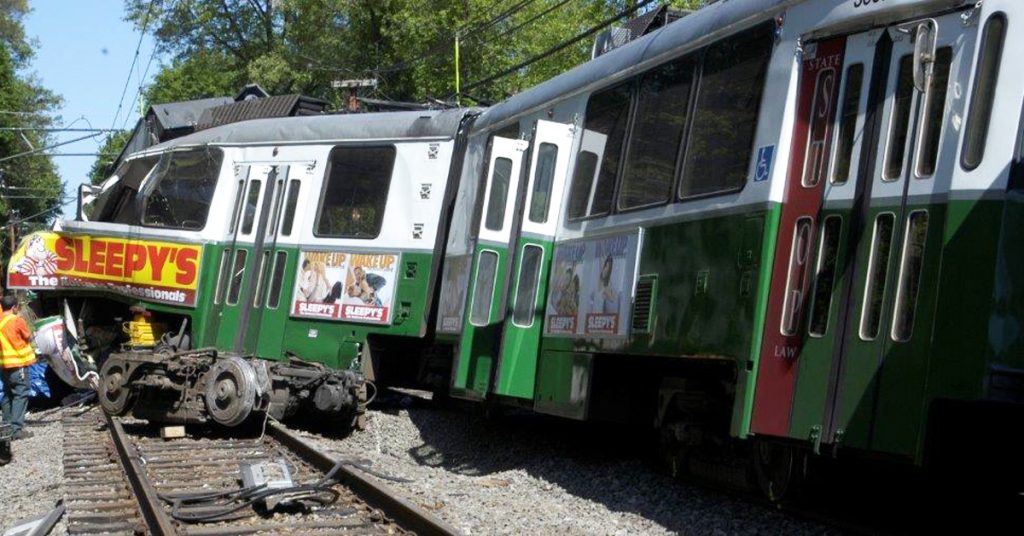Posts Tagged ‘Green Line trolley accident lawyers’
MBTA Derailments Cause Boston Commuters Injuries, Stress and Delays

The MBTA saw 43 train derailments over five years, many Green Line trolley derailments. (File photo: bwglaw.com)
Two MBTA subway derailments have injured over a dozen and shaken hundreds of Boston commuters over the past week. At least 12 of the injured passengers were transported to local hospitals. You are not alone if you are watching and wondering if Boston’s subways are safe for use.
According to news reports, the first derailment happened over the weekend (June 9, 2019), when a Green Line trolley derailed in a tunnel near Kenmore Square. This accident happened about 11 a.m. Police and firefighters aided 150 passengers off the derailed trolley and out of the dark tunnel. Another 500 startled passengers were evacuated from other trolleys along the Green Line. Eleven people were injured, with 10 people sent to local hospitals. The Green Line trolley operator was among those injured.
Soon after, The Boston Globe reported the train derailment was not due to aging infrastructure or equipment, but was “operator-related.” The MBTA suspended the 62-year-old operator pending the outcome of the investigation.
WHDH reported the operator had three years of experience operating trains. Meanwhile, The Boston Globe reported the train derailed after the outbound D Line train left Kenmore Square. The trolley operator approached a signal marking where the D and C lines split (near Beacon Street and Commonwealth Avenue). He kept traveling over a switch that was in the process of switching between the lines.
Then Tuesday morning (June 11, 2019), a Red Line train derailed near the UMass Boston campus and the John F. Kennedy presidential library. About 60 passengers were evacuated. Despite the terrifying scene, just two people were treated for injuries. One was treated for a hand injury at the scene. Another person initially left the crash scene, then returned, asking to be transported to a hospital for neck pain.
Crews were still working to repair the Red Line damage Wednesday, leaving hundreds of commuters without their usual way into Boston. The Red Line provides services through Quincy, downtown Boston and Cambridge. The line ends at Alewife station.
The 39-year-old operator has been taken off duty pending the outcome of the investigation, according to WHDH.
According to MBTA ridership figures, the red line carried 272,000 people daily in 2013. This makes it the busiest subway line. The Green Line was second, with 227,000 passengers. The Green Line and the Mattapan Line are the only light-rail trolley systems.
Unfortunately, MBTA train derailments are more common than the public may realize. The Boston Globe reports MBTA trains have derailed 43 times over the past five years. This is the second-worst safety record in the U.S.
Train derailments must be thoroughly investigated by an experienced lawyer. Causes can include operator error, cell phone use, texting or speeding. Aging infrastructure and equipment failure are other potential causes.
If You Were Injured in a MBTA Train Derailment
If you were injured, it is in your best interest to receive a medical evaluation from a hospital or your physician. Then consult an experienced MBTA accident lawyer and learn your legal rights.
With more than 100 years combined experience, Breakstone, White & Gluck is experienced in representing individuals who have been injured by the MBTA. Our attorneys have investigated and represented clients injured by Green Line trolley collisions, MBTA bus crashes and other accidents. We have also represented families who have lost loved ones in MBTA accidents.
For a free legal consultation, contact Breakstone, White & Gluck at 800-379-1244 or 617-723-7676. You can also use our contact form.


